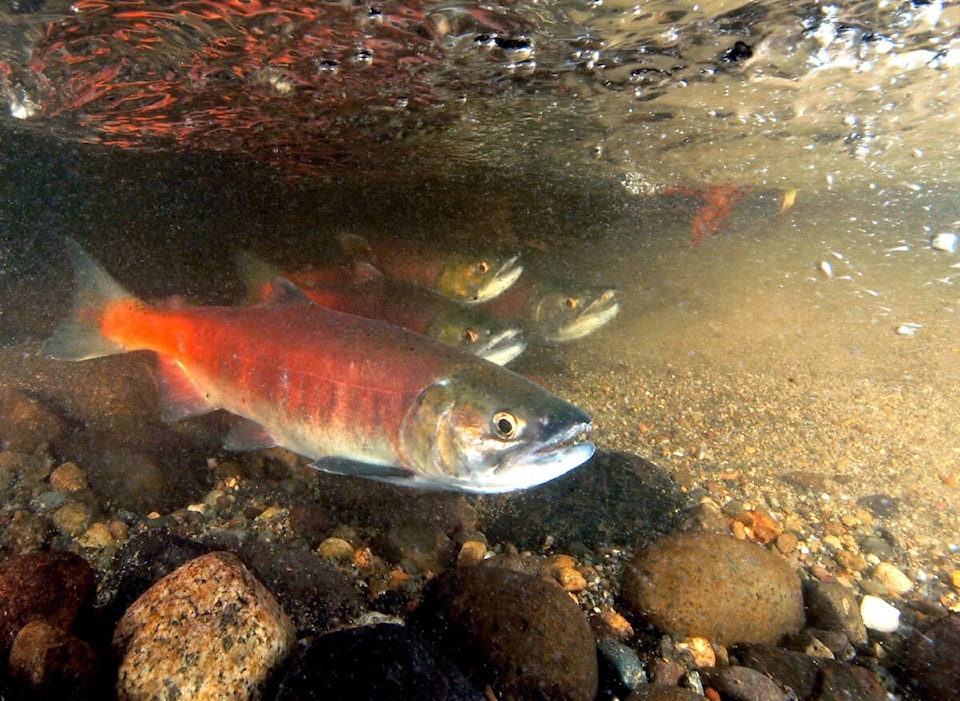A set of scale and fin samples taken from kokanee salmon in and near Kluane National Park were taken in the 1980s, tucked into storage and forgotten about.
The samples were found in 2013, when national park employees were moving from one office to another. They would prove essential for research on fish health.
Kokanee salmon are the landlocked cousins of the ocean-running sockeye salmon. The fish living in Kathleen Lake, one of the most popular locations for visitors in the national park, are the northernmost kokanee population in Canada.
A recent study of the kokanee population was conducted by the University of British Columbia Okanagan (UBCO).
Work to assess the genetic diversity of the kokanee population was important because of concerns that it had been damaged by a population crash in the early 2000s. According to UBCO, the historical average number of spawning kokanees among the population that lived in the lake was 3,660. Those numbers saw a steep drop down to an all-time low of only 20 spawning fish in 2009.
Conservation efforts led to a rebound in the population of spawning kokanee making their way through the chain of lakes and creeks draining into Kathleen to produce the next generation. Although the number of fish was higher questions remained about whether the population’s genetic diversity had been irreparably damaged and how that might impact its long-term resilience.
The answers to those questions lay in the fin and scale samples taken decades before.
Carmen Wong, the ecologist team leader for Kluane National Park, found the kokanee samples in 2013. She said that when the samples were taken in the 80’s, researchers would have had no way of predicting the kokanee population crash of the coming decades and also lacked genetic analysis techniques.
Upon finding the samples that were taken before the Kathleen Lake kokanee population crashed — and so able to provide a picture of genetic diversity before the collapse — Wong knew it was important to get them in the hands of the right researchers.
Wong said like other salmon, the population of the Kathleen Lake kokanee goes through significant fluctuations. Genetic diversity is important to weathering these changes in the number of spawning fish.
Dr. Michael Russello and master’s student Chris Setzke set out to determine if the genetic health of the population had been seriously compromised by the population crash of the early 2000s. To do so, they compared the fin and scale samples from the 1980s with new ones.
Russello said DNA sequencing techniques have advanced rapidly and UBC researchers were able to employ some new approaches to analyze the DNA from the 40- and 50-year-old samples.
“If we had not had access to these archival samples, inappropriate conservation initiatives may have been enacted, misdirecting resources or even potentially leading to adverse outcomes for the kokanee population in KNPR,” Russello said.
Researchers used a method called genotyping-in-thousands by sequencing (GT-seq) to analyze the historical samples. Setzke said GT-seq needs only short fragments of DNA to obtain genetic information and can be used on thousands of individuals at once.
“As archival DNA tends to be damaged, it is difficult to sequence using methods that need long, intact fragments,” Setzke explained.
“While GT-seq has been in use for a few years now, ours is the first study to show that it can be employed to effectively sequence archival DNA.”
The researchers were able to determine that there was no significant loss of diversity resulting from the population decline. By including the historical samples in their analysis, it became clear to researchers that potentially concerning genetic signatures found in the newer samples were present before the population decline.
The other point of comparison in the UBCO study was with the hatchery kokanee population at the Whitehorse Rapids Fish Hatchery. The hatchery population was established using fish from Kluane in the 1990s but the research found that these captive fish are no longer genetically similar to the wild population meaning that hatchery kokanee shouldn’t be used to restore the population in Kathleen Lake.
“Without these studies, it is possible that KNPR would have been stocked unnecessarily with hatchery kokanee,” Russello said. “This could have ultimately reduced the fitness of the wild salmon populations in that system, which is the opposite of the intended conservation goals.”
Historic samples were also taken from a kokanee population in Frederick Lake, just outside the national park boundary, that is now believed to be extirpated. Wong said the genetic work shows the Frederick Lake population was significantly different from the fish in Kathleen Lake only 30 kilometres away. She said questions remain about how low genetic diversity contributed to the loss of the Frederick Lake population.
She added that following the UBCO research there is cautious optimism that the Kathleen Lake population has the necessary resilience to survive population rises and declines.
The work done on the Yukon kokanee will inform a larger project that is ongoing to assess the genetic health of kokanee across their entire Canadian range. Russello said the ongoing work is a team effort with Parks Canada, Genome BC and other groups that are taking a whole genome sequencing approach to investigating the diversity and structure of the kokanee population across British Columbia and the Yukon. This work will help researchers better understand the unique features of the Kluane National Park population.
“Population crashes have been observed elsewhere in the range, including two particularly important stocks in Meadow Creek and Wood Lake to the south in B.C. The on-going whole genome studies should provide important insights into population history and local adaptation for stocks across Western Canada,” Russello said.
Contact Jim Elliot at jim.elliot@yukon-news.com
